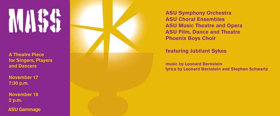Review: ASU Herberger Institute School of Music Presents Bernstein's MASS ~ A Masterpiece Of Artistic Collaboration

Among the various programs to celebrate the centenary of Leonard Bernstein's birth, I daresay that none has been more ambitious in its design and more fulfilling in its execution than the mounting of the maestro's MASS by ASU's Herberger Institute School of Music.
In the course of two performances during the weekend of November 17th, the combined talents of students and performers from Arizona State University's Symphony Orchestra and Choirs, Music Theatre and Opera, and School of Film, Dance and Theatre, joined by members of the Phoenix Boys' Choir, fused together in a masterpiece of artistry and collaboration.
The performances by these young creatives ~ singers, dancers, musicians, and technicians ~ also left an indelible note of assurance and encouragement that a wealth of inspired and energetic talent, cultivated and developed by the academy and local nonprofits, stands ready in the wings to entertain and uplift future audiences.
Adding luster to the occasion was the special appearance (made possible by a grant from the Andrew W. Mellon Foundation) of famed baritone Jubilant Sykes as the Celebrant, the priest whose hold on faith is challenged by a generation whose trust in institutions and religion has been diminished by social and spiritual crisis.
That crisis was a dominant force in the period that impelled Jacqueline Kennedy's request to Bernstein for a work to celebrate the 1971 opening of the Kennedy Center for the Performing Arts.
It would be fair to say that the crisis of confidence and conscience may never have abated, that it has percolated over time, and that today, in a madly divisive political environment, it has been exacerbated. Thus, notwithstanding the controversy that has surrounded MASS, Thanksgiving Season 2018 is a very good time to be treated to a work that offers messages of harmony and peace. In this regard, the ASU producers of MASS have excelled.
In preparing to review ASU's production of MASS, brilliantly directed by David Lefkowich, I was aware of both the praise and controversy it has engendered (the latter most dramatically expressed recently by Zachary Woolfe, the New York Times's classical music editor (Mass' Brings Out the Worst in Leonard Bernstein).
After experiencing the two-hour "theater piece for singers, players and dancers," I found myself somewhat sympathetic to Woolfe's critique, allowing that Bernstein tossed everything but the kitchen sink into the composition ~ over 300 bodies, a marching band, a rock band, a blues band, a full orchestra, multiple choirs, four dance groups, motifs reminiscent of his spirited Broadway musicals, etc., etc.). Yet, MASS is a melding of cacophony and harmony, somewhat akin to sound and fury, but in the end, in the harmonic convergence that is the final of thirty-two movements, signifying something transcendent and elevating.
MASS's message is in the medium, a full-throttle synthesis of form and movement and vocalization. As grandiose as was the entirety of this production, it is to the parts that we must pay reverence, each excelling in splendor under the guidance of their directors and the work of scores of designers and crew. The grand sounds of the ASU Orchestra, under the baton of Jeffery Meyer, reverberated throughout all corners of Gammage Auditorium, performing at a level of quality equal to any professional orchestra. Diverse bands rocked the hall. Imaginative projections of a swirling firmament and images of on-stage action added dimension to the production. Dancers moved with agility and suppleness like forces of nature to the interpretive choreography of Carley Condor, Molly Lajoie, David Olarte and Marcus White. Boys sang like angels, an attribute so distinctively owned by the award-winning Phoenix Boys Choir, under the direction of Georg Stangelberger, and best exemplified by the remarkable solo performance of young Nathan Shenk.
The echoes of this magnificent production still resound, a testament to the power and value of artistic collaboration in bringing us closer to all that is sacred.
- Music by Leonard Bernstein
- Lyrics by Leonard Bernstein and Stephen Schwartz
- ASU Symphony Orchestra ~ Jeffery Meyer, conductor and music director
- ASU Choral Ensembles ~ David Schildkret, choral director
- ASU Music Theatre and Opera ~ Brian DeMaris, artistic director
- Phoenix Boys Choir ~ Georg Stangelberger, Harvey K. Smith Artistic Director
- ASU School of Music set design ~ Alfredo Escarcega
- Music Theatre and Opera costumes, wigs and makeup ~ Sharon Jones
- Music Theatre and Opera lighting design ~ Alan C. Edwards
- Media design ~ Dallas Robert Nichols
- Sound design ~ Almir Lejlic
Poster credit to ASU School of Music
Reader Reviews
Videos

